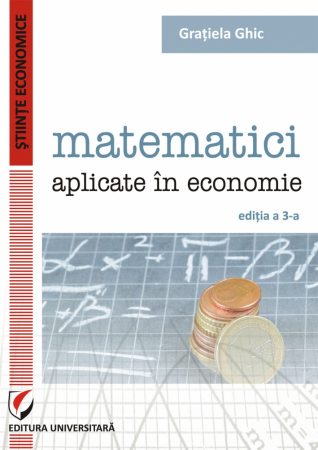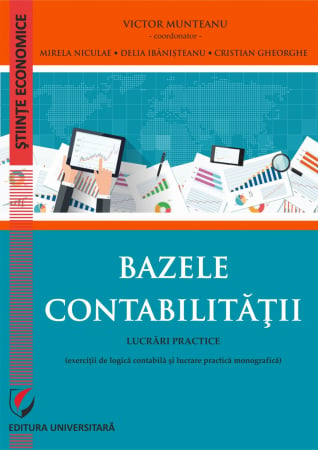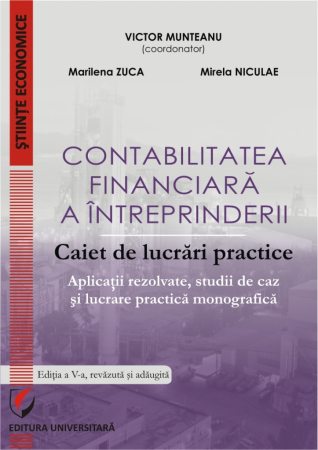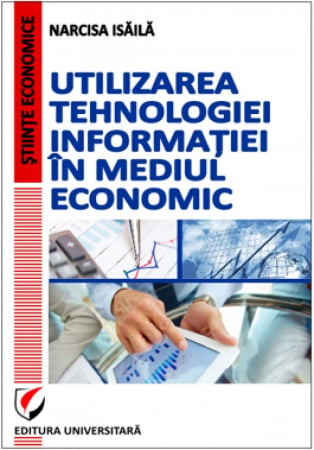6359.png) Set of books: Financial Management of the Enterprise. Conceptual Landmarks + Financial Management of the Enterprise. Practical Work
Set of books: Financial Management of the Enterprise. Conceptual Landmarks + Financial Management of the Enterprise. Practical Work
6359.png)
ISBN: 978-606-28-0494-7, 978-606-28-0991-1
DOI: 10.5682/9786062804947, 10.5682/9786062809911
Publisher year: 2016,2019
Pages: 338
Publisher: Editura Universitară
Author: Roxana Arabela Dumitrascu
- Description
- Download (2)
- Authors
- Content
- More details
- Reviews (0)
The financial function is one of the most important responsibilities that a modern enterprise must assume in order to successfully achieve its global mission - creating and maximizing economic value. The critical character of the financial field is determined by the fact that, at enterprise level (but not only), economic efficiency acquires relevance and conclusion only if it is expressed through financial-monetary categories and indicators. Of course, there are other dimensions of enterprise efficiency, non-financial and non-monetary, just as important as, for example: product quality, customer satisfaction, internal climate, image and reputation, ecological impact, social effects , contribution to technological progress, etc.
The particularity and advantage of the financial perspective on the efficiency of the enterprise results from the possibility of precise quantification of economic effects and efforts with the help of financial-monetary aggregates, ensuring, on this objectified basis, comparability over time of data on performance and performance of the enterprise. Also, the approach of the enterprise activity through the prism of finances allows the rigorous and pertinent analysis of the generative factors of the success or failure of the enterprise. These arguments support the necessity and importance of the financial management of the enterprise as a distinct field of management.
This course was conceived and developed based on the ideas set out above on the nature and content of the discipline Financial management of the enterprise. The course included aspects and topics of major importance, such as: financial analysis of the enterprise, financial balance, short-term financial management, financial planning, investment management, long-term financial decisions, etc. The specificity of this course consists in the permanent association and reporting of the financial phenomena to other specialized fields identifiable within the enterprise - logistics, production, marketing, human resources, general strategy. Finances cannot be isolated from the whole enterprise. The interaction of financial and non-financial factors is the force that propels the company towards performance. Moreover, this argument justifies the inclusion of a separate chapter, dedicated to the goodwill and intellectual capital of the enterprise as areas of interference and osmosis between financial and non-financial phenomenology manifested at the enterprise level. We believe that such a mixed approach can only stimulate a deeper understanding of the real springs of the company's performance.
This course supports both students from the specializations "Finance - Banking" and "Accounting and Management Informatics", as well as practitioners interested in modern and efficient ways of managing the company's finances. In this sense, the exposition of the paradigms and theoretical concepts is illustrated and completed with the help of a rich palette of problems and solved applications. Readers also have the opportunity to strengthen their practical skills in the field of financial management of the enterprise by
"Solving" some problems proposed for solution. We sincerely hope that this work will be a real guide in the world of microeconomic finance, a world of paradoxes animated both by incandescent passions and cold calculations.
Assoc. Dr. Roxana Arabela Dumitrascu
Education:
Faculty of Economics, University "Petre Andrei" of Iasi, specializing in Finance and Accounting (2001);
Post-graduate School of the University FIBAS "Al. I. Cuza" Iasi, master's degree in Economics and Financial Management & Banking (2005);
Academy of Economic Studies (2010), PhD in Finance;
Romanian Academy, SPODE, post-doctoral studies in economics.
Activity:
2001-2011 professor at the Faculty of Economics of the University "Petre Andrei" of Iasi;
2012 Ph.D. Lecturer at the Faculty of Finance, Banking and Accounting, of Christian University "Dimitrie Cantemir" of Bucharest, owner of enterprise financial management courses, insurance and reinsurance and risk management in insurance and reinsurance.
Publications:
Single author: Financial management company. Self-study manual (2012), Insurance and reinsurance. Self-study manual (2012), Prices and and competitivity. Self-study manual (2012), Management of the goodwill value (2008).
Coauthor: Intangible firm capital management (2009), Drift Management (2005), Management versus postmodernity (2005), Defiance complexity (2004), Elements of evaluating companies (2002).
Over 70 articles and studies published in scientific journals.
Introduction / 9
Chapter 1
Fundamental concepts regarding the financial management of the enterprise / 12
1.1. Content of the financial management of the enterprise / 12
1.2. Fundamental tasks of the financial management of the enterprise / 14
1.3. Integration of the financial management of the enterprise in the management system of the enterprise / 19
1.4. Questions, tests, applications / 23
Chapter 2
Normalization of financial-accounting information / 26
2.1. Balance sheet / 26
2.2. The inaccuracies of the accounting information and the necessity of its processing / 32
2.3. The structure of the financial balance / 35
2.4. Regulation of accounting information in order to move to the functional balance sheet / 49
2.4.1. The finances of the enterprise in the functional conception / 49
2.4.2. The need to build a functional balance sheet / 51
2.4.3. Functional balance / 52
2.5. Questions, tests, applications / 59
Chapter 3
Analysis of static financial balance / 64
3.1. The notion of financial balance at enterprise level / 64
3.2. Estimation of the balance based on the financial balance / 65
3.2.1. Solvency assessment / 66
3.2.2. Liquidity assessment / 67
3.3. Estimation of the balance based on the functional balance / 80
3.4. Questions, tests, applications / 88
Chapter 4
Analysis of financial performance and profitability of the enterprise / 93
4.1. Intermediate management balances / 93
4.2. Self - financing capacity / 107
4.3. Profitability rates / 111
4.3.1. Commercial profitability rates / 111
4.3.2. Economic profitability rates / 113
4.3.3. Financial profitability rates / 115
4.4. Capital turnover rates / 127
4.5. Questions, tests, applications / 128
Chapter 5
Analysis of the dynamic financial balance / 135
5.1. Financing table / 135
5.2. Cash flow statement / 139
5.3. Available cash flow / 141
5.4. Questions, tests, applications / 144
Chapter 6
Analysis of the financial situation of the enterprise based on the installment system / 147
6.1. Financial balance rates / 147
6.2. Debt rates / 150
6.3. Rates regarding the structure of assets and liabilities / 151
6.4. Questions, tests, applications / 162
Chapter 7
Analysis of the economic and bankruptcy risks of the enterprise / 167
7.1. The notion of risk at enterprise level / 167
7.2. Profitability threshold analysis / 173
7.3. Structural exploitation risk analysis / 177
7.4. Analysis of the sensitivity of the result in relation to the activity level / 181
7.5. Questions, tests, applications / 184
Chapter 8
The enterprise 's financial forecasting system / 189
8.1. The business plan of an enterprise / 189
8.2. The set of enterprise budgets / 193
8.3. Revenue and expenditure budget / 207
8.4. Profit and loss account projection / 212
8.5. Projection of the simplified balance sheet / 214
8.6. Questions, tests, applications / 219
Chapter 9
Management of the enterprise operation cycle / 224
9.1. Operating cycle structure / 224
9.2. Enterprise inventory management / 227
9.3. Questions, tests, applications / 238
Chapter 10
Sizing the financial needs of the operating cycle / 242
10.1. Operating cycle financing requirement (NFCE) / 242
10.2. Analytical methods for establishing NFCE / 245
10.3. Synthetic methods for establishing NFCE / 252
10.4. Ways of financing the operating cycle / 254
10.5. Questions, tests, applications / 257
Chapter 11
Investment management / 262
11.1. General notions regarding investments / 262
11.2. Investment project / 263
11.3. Financial evaluation of investment feasibility / 265
11.4. Questions, tests, applications / 275
Chapter 12
Long - term enterprise financing / 278
12.1. The financial structure of the enterprise / 278
12.2. The own funds of the enterprise / 280
12.3. The borrowed funds of the enterprise / 281
12.4. The cost of financing the enterprise / 283
12.5. Questions, tests, applications / 285
Chapter 13
Profit - sharing decisions / 288
13.1. Scope of net profit distribution decisions / 288
13.2. The effects of profit sharing decisions / 289
13.3. Factors that favor the reinvestment of profits / 290
13.4. Content and typology of dividend policies at enterprise level / 292
13.5. Questions, tests, applications / 298
Chapter 14
Intangible capital as an object of the financial management of the enterprise / 300
14.1. The goodwill of the enterprise - conceptual specifications / 300
14.2. Goodwill as a financial expression of intellectual capital / 305
14.3. Quantifying the goodwill of the enterprise / 307
14.4. The concept of intellectual capital of the enterprise / 318
14.5. Goodwill as a tool for financial management of the enterprise / 323
14.6. Questions, tests, applications / 332
Bibliography / 335
Financial management of the enterprise. Practical works - Contents
PART 1
ANALYSIS BASED ON THE FINANCIAL BALANCE SHEET / 7
1.1. Construction of the financial balance sheet (based on the balance sheet) according to liquidity-exigibility criteria / 7
1.2. Net accounting asset indicator. Interpretation / 13
1.3. Determining the financial working capital. Interpretation / 14
1.4. Own working capital and borrowed working capital / 15
1.5. The need for working capital, net cash and cash flow for the period / 17
PART 2
ANALYSIS BASED ON THE FUNCTIONAL BALANCE SHEET / 21
2.1. Construction of the functional balance sheet / 21
2.2. Calculation of the global net working capital / 24
2.3. Total working capital requirement and net treasury / 25
PART 3
ESTIMATING THE PROFITABILITY OF THE ENTERPRISE / 29
3.1. Commercial margin, added value and net result / 29
3.2. Self - financing capacity / 31
3.3. Commercial profitability / 32
3.4. Economic profitability and financial profitability / 32
PART 4
DEBT RATES AND LIQUIDITY RATES / 35
4.1. Debt rates / 36
4.2. Liquidity rates / 37
PART 5
FINANCIAL-EQUITY STRUCTURE OF THE ENTERPRISE / 39
5.1. Asset structure rates / 40
5.2. Liability structure rates / 40
5.3. Analysis of the financial structure of the enterprise Y / 41
PART 6
PROFITABILITY THRESHOLD / 42
6.1. Sales price for monoproductive enterprises / 42
6.2. Calculation of the break - even point / 43
6.3. Indicators associated with the break - even point / 45
PART 7
STOCK MANAGEMENT / 49
7.1. Determination of stocks under certainty (Wilson-Whitin Model) / 49
7.2. Determining the financing need for the operating cycle by the extrapolation method (global method) / 50
PART 8
INVESTMENT MANAGEMENT / 52
8.1. Capitalization and updating / 52
8.2. Indicators for assessing the efficiency of investments / 54
PART 9
THE COST OF FINANCING THE ENTERPRISE / 57
The financial function is one of the most important responsibilities that a modern enterprise must assume in order to successfully achieve its global mission - creating and maximizing economic value. The critical character of the financial field is determined by the fact that, at enterprise level (but not only), economic efficiency acquires relevance and conclusion only if it is expressed through financial-monetary categories and indicators. Of course, there are other dimensions of enterprise efficiency, non-financial and non-monetary, just as important as, for example: product quality, customer satisfaction, internal climate, image and reputation, ecological impact, social effects, contribution to technological progress, etc.
The particularity and advantage of the financial perspective on the efficiency of the enterprise results from the possibility of precise quantification of economic effects and efforts with the help of financial-monetary aggregates, ensuring, on this objectified basis, comparability over time of data on performance and performance of the enterprise. Also, the approach of the enterprise activity through the prism of finances allows the rigorous and pertinent analysis of the generative factors of the success or failure of the enterprise. These arguments support the necessity and importance of the financial management of the enterprise as a distinct field of management.
The sphere of the financial management of the enterprise is circumscribed by the totality of the managerial decisions and options that aim at attracting and the rational and sustainable allocation of the financial resources of the enterprise. The major objective of the financial management of the enterprise consists in the long-term maximization of the economic value of the initial capital investment made by the shareholders of the enterprise. In this way, the approaches regarding the financial management of the enterprise must be subordinated to the restrictions and development priorities deriving from the general business strategy promoted by the enterprise. Considering the mentioned conditions, we specify that the financial management has the role of ensuring the financial support of the enterprise strategy. For this purpose, the financial management of the enterprise is obliged to make an extremely difficult and delicate arbitration, between the short-term and the long-term financial constraints to which the business is subject.
The approach requires, without a doubt, a predictive, anticipatory approach of the system of financial factors and processes that shape, in one sense or another, the dynamics of the enterprise. In other words, financial management involves a very careful control of the economic and financial risks likely to affect the company, especially in a fluid and uncertain business context. Maintaining the main financial balances and maximizing the financial performances in the conditions of reasonable risks outlines, therefore, the preferential maneuvering area of the financial management of the enterprise. The optimization of the internal financial flows and the financial relations with the economic environment, especially with the financial-banking market, is presented, therefore, as the fundamental stake of the financial management of the enterprise. The harmonization of the financial cycles (financing and investments) and of the exploitation cycles (associated to the operations of supply, manufacture, storage, sales) constitute, for this reason, the very essence of the financial management of the enterprise.
For the financial management of the enterprise, the slogan "Maximizing opportunities and minimizing risks" would be an extremely accurate and edifying synthesis of issues and concerns. Prudence, reasonableness, responsibility and feasibility are the basic criteria in financial decision making processes. In the financial management of the enterprise, the application of these principles materializes in a wide and diversified arsenal of quantitative models and techniques whose purpose is to ensure the objective and substantiated nature of the reasoning and conclusions based on which the management of the enterprise will design its decisions and plans. finance.
This course was conceived and developed based on the ideas set out above on the nature and content of the discipline of the enterprise. The course included aspects and topics of major importance, such as: financial analysis of the enterprise, financial balance, short-term financial management, financial planning, investment management, long-term financial decisions, etc. The specificity of this course consists in the permanent association and reporting of the financial phenomena to other specialized fields identifiable within the enterprise - logistics, production, marketing, human resources, general strategy. Finances cannot be isolated from the whole enterprise. The interaction of financial and non-financial factors is the force that propels the company towards performance. Moreover, this argument justifies the inclusion of a separate chapter, dedicated to the goodwill and intellectual capital of the enterprise as areas of interference and osmosis between financial and non-financial phenomenology manifested at the enterprise level. We believe that such a mixed approach can only stimulate a deeper understanding of the real springs of the company's performance.
This course supports both students from the specializations "Finance - Banking" and "Accounting and Management Informatics", as well as practitioners interested in modern and efficient ways of managing the company's finances. In this sense, the exposition of the paradigms and theoretical concepts is illustrated and completed with the help of a rich palette of problems and solved applications. Readers also have the opportunity to strengthen their practical skills in the field of financial management of the enterprise by "Solving" some problems proposed for solution. We sincerely hope that this work will be a real guide in the world of microeconomic finance, a world of paradoxes animated both by incandescent passions and cold calculations.
Assoc. Dr. Roxana Arabela Dumitrascu

![Set of books: Financial Management of the Enterprise. Conceptual Landmarks + Financial Management of the Enterprise. Practical Work [1] Set of books: Financial Management of the Enterprise. Conceptual Landmarks + Financial Management of the Enterprise. Practical Work [1]](https://gomagcdn.ro/domains/editurauniversitara.ro/files/product/large/set-of-books-financial-management-of-the-enterprise-conceptual-landmarks-financial-management-of-the-enterprise-practical-work-543-4624.png)














